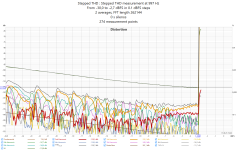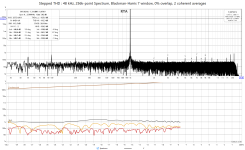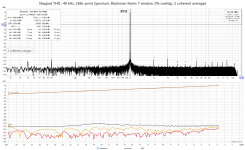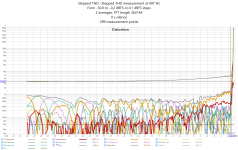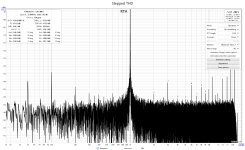I'd be concerned about security risks. I'd definitely not plug that equipment into a network that had internet access. That usually means that data from the test equipment needs to be transported by USB stick to anything that uses said data. That's not exactly convenient.Why is the ancient OS a deal-breaker? You can upgrade the UPV to Win-7, but we haven't bothered on any of our UPVs. What more do you want from an AA that modern OS offers?
Tom
Another solution is to maintain two networks, one with Internet access and another without. Computers with two NICs can connect to both.
ETA: Set up the routing tables to send Internet traffic to the first NIC and local traffic to the second.
Ed
ETA: Set up the routing tables to send Internet traffic to the first NIC and local traffic to the second.
Ed
I have a VLAN set up for exactly that. I'm still not super keen on letting a client that hasn't been fully updated onto my main LAN, though.
Tom
Tom
When a computer has two nics it is effectively a router with a set of rules. If that computer gets hacked, then its simple for an attacker to connect to the other computer's (formerly private) network.
Regarding the "up to date" computer, there are always zero-day exploits. Years ago we used to use a Qualys appliance on the main VPN network with nightly updates for detection of the latest threats.
The best security is to have critical computers isolated or on strictly controlled private networks. The used to put hot melt glue into all the USB sockets on those PCs, lock the cases, etc., and generally make it hard for someone to compromise such PCs.
Okay, the situation here is much less critical, but still you need to do regular backups of critical PCs where the backups don't get overwritten (in case there is a time-bomb threat added to the PC at some point in time).
Regarding the "up to date" computer, there are always zero-day exploits. Years ago we used to use a Qualys appliance on the main VPN network with nightly updates for detection of the latest threats.
The best security is to have critical computers isolated or on strictly controlled private networks. The used to put hot melt glue into all the USB sockets on those PCs, lock the cases, etc., and generally make it hard for someone to compromise such PCs.
Okay, the situation here is much less critical, but still you need to do regular backups of critical PCs where the backups don't get overwritten (in case there is a time-bomb threat added to the PC at some point in time).
Last edited:
The routing rules do not forward traffic from one network to the other. Don't let the computers on both networks get hacked.Makrw4 said:When a computer has two nics it is effectively a router with a set of rules. If that computer gets hacked, then its simple for an attacker to connect to the other computer's (formerly private) network.
Ed
Not by default. But you can program/configure/root it one way or another 🙂
We used to configure routing on Windows 7 Enterprise Edition now and then.
With the latest Windows OS versions, it does take some extra doing to turn it into a router. However, becoming Admin on the machine with two nics offers a lot of possibilities.
Obviously, the reason there are periodic Windows security updates is because of threat vectors that keep being discovered. And then there is the old "human engineering" threat: Just click here... 🙂
We used to configure routing on Windows 7 Enterprise Edition now and then.
With the latest Windows OS versions, it does take some extra doing to turn it into a router. However, becoming Admin on the machine with two nics offers a lot of possibilities.
Obviously, the reason there are periodic Windows security updates is because of threat vectors that keep being discovered. And then there is the old "human engineering" threat: Just click here... 🙂
Last edited:
I would want to set up something like this:
1) main internet access with proper firewall
2) IOT islated network to the internet with a firewall so the hacked IOT stuff doesn't affect anything important
3) Isolated network with no internet access but accessable from 1 above of the obsoleted stuff that still works.
A premium switch/router should be able to do this effectively. However not trivial setup. I'm sure someone here can provide guidelines.
1) main internet access with proper firewall
2) IOT islated network to the internet with a firewall so the hacked IOT stuff doesn't affect anything important
3) Isolated network with no internet access but accessable from 1 above of the obsoleted stuff that still works.
A premium switch/router should be able to do this effectively. However not trivial setup. I'm sure someone here can provide guidelines.
Sure, but there have also been attacks on hardware router OS'es. That includes the big guys too, like Juniper and Cisco.
Basically, the problem is that the internet was not designed from the start to be impervious to bad actors. Things were added such as IPsec, and so on that maybe could help some, but some of those were never much used. Too easy to spoof an IP address and or a MAC address
Basically, the problem is that the internet was not designed from the start to be impervious to bad actors. Things were added such as IPsec, and so on that maybe could help some, but some of those were never much used. Too easy to spoof an IP address and or a MAC address
Guys there is no save network or secure data. If you do not want to share data, do not put it on a computer.
If you do, make daily backups and backups from the backup.
And now back on topic. 🙂
If you do, make daily backups and backups from the backup.
And now back on topic. 🙂
We have 5 UPVs and got the first around 2012. At no point has there every been a need / desire to connect them to a network. The UPV has USB on the front. It may take an extra 10 seconds to put a stick into one and move to another compared to doing so via a network, but it's not exactly a hardship. My CAD PC never, ever goes near the web. I'm a fan of keeping tools offline.I'd be concerned about security risks. I'd definitely not plug that equipment into a network that had internet access. That usually means that data from the test equipment needs to be transported by USB stick to anything that uses said data. That's not exactly convenient.
Tom
Inspiring work man, thank you very much.Thanks for the input. btw I've taken a fair amount of advice already. ++
Pararallell input on ADCiso. 640 ohm setting
ESS 9039 card with i2s input from ADAU card. No master clock from ADAU. Crystal on DAC board. SPDIF in in ADAU.
And this is with cheap power supply to the card. 1,785V RMS out of DAC for 0dBFS on ADC. Quite some voltage devision on output resistors of DAC and input of ADC. 100 ohm output resistance?
So a ADAU can get into the mix to control clocks and syncronize measurement signals if I would like to make a setup for myself.

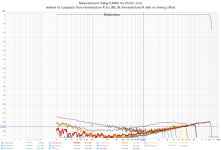
ESS 9039 card with i2s input from ADAU card. No master clock from ADAU. Crystal on DAC board. SPDIF in in ADAU.
And this is with cheap power supply to the card. 1,785V RMS out of DAC for 0dBFS on ADC. Quite some voltage devision on output resistors of DAC and input of ADC. 100 ohm output resistance?
So a ADAU can get into the mix to control clocks and syncronize measurement signals if I would like to make a setup for myself.


Last edited:
That's the total noise (including any non-harmonic distortion) across the chosen span.Dont know why REW report the 'high' noise though in the stepped responce
Yes, miscalculated. The 2.5uV of noise corresponds to -116dBr.
To much spurea from the unregulated +/-15volt switched regulator
To much spurea from the unregulated +/-15volt switched regulator
Noise is integrated over the measuring bandwidth. The same applies to THD+N, N component. This is absolutely correct. Noise must not be confused with noise density, which is scaled in V/rt(Hz) and tells about noise in 1Hz bandwidth. Unfortunately many readers do not understand noise definitions.Dont know why REW report the 'high' noise though in the stepped responce
Last edited:
- Home
- Design & Build
- Equipment & Tools
- Measuring Distortion on the Cheap

